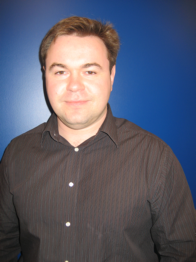Electronic devices fabricated at CMOS backend-compatible temperatures
Promotion date: 17. December 2009
Promotor: Prof. Dr. Jurriaan Schmitz
| Three-dimensional integration of IC’s, is nowadays a serious alternative to further lateral downscaling. Techniques were developed for the monolithic 3-D integration of IC’s, by vertical integration of several active layers through sequential processing, focussing on two key-processes: low-temperature deposition of semiconducting and dielectric films; and performance enhancement of silicon films by means of green laser crystallization and dopant activation. Several types of electronic and photonic devices were realized using low-temperature processing steps. The obtained non-volatile memory devices with Si-nanodot floating gate, perform both good program and erase behaviour. Additionally, silicon nanodots exhibit quantum confined near-infrared photoluminescence and electroluminescence in optically active structures, resulting in a “blue-shift” of emission spectra. High-performance p- and n-channel poly-Si TFTs were fabricated, using laser crystallized silicon films and low-temperature deposition steps. Since the random grain boundaries are found at predictable positions, this allows the transistor definition away from these boundaries. CMOS inverters and fully functional 51-stage ring oscillators were fabricated, using the same process steps. Ring oscillators with suppositional optimal location of TFT-channels showed improved performance. The processes described in thesis can be employed for large-area TFT electronics as well as a functional stack layer in 3‑D integration, due to their low thermal budgets and their CMOS backend-compatibility. |
Why are low temperatures needed for this kind of 3-D techniques?
The thermal treatment during 3-D integration cannot exceed 450 °C. Such a restriction is needed because otherwise damage to the underlying layers can occur, while building a next device layer. Low-temperature deposition techniques were done in a custom-designed cluster system, which provides the possibility of depositing various layers in sequence without a vacuum break.
The thesis project was successful, in the way that besides designing these new process steps, also the crystallisation of silicon, using green laser, and measuring the functionality of the devices, all had their fair share of attention, resulting in nice outcomes.
So no surprises happened ...?
We discovered a very interesting spin-off result coming out from our multilayered structures. The created nanodots appeared to emit near-infrared light and, when we reduced their size, the spectra shifted clearly to the visible range, so-called “blue-shift”. In cooperation with the Photonic Materials group of the FOM Institute for Atomic and Molecular Physics in Amsterdam, a silicon-nanodots-based source for surface plasmon polaritons, was fabricated and characterised. A publication on this topic is accepted already by Nature Materials, to be published in January 2010.
Did you cooperate with other institutes as well?
With regard to the crystallization part, we worked with a company Innovavent in Göttingen, Germany, who produces specialized laser equipment. Within Mesa+ we worked closely together with cleanroom experts, of course, and with groups who possessed certain measuring equipment. For example, before our group ordered a spectroscopic ellipsometer of their own, we used one from IOMS group. Also some AMF measurements were done at the TST group.
What are your future plans?
First, I concentrate on my work as a post-doc here. I am given the opportunity to complete the investigations on photonic devices based on silicon nanodots. The expected results should be really interesting.
After that, I would like to apply for a research job in the industry. Applied electronics and physics, in a broad sense, is my main ambition, to prove developments which are possible in the practical field. On the other hand, I am not excluding the possibility to stay active in academic research.
In the future I hope to stay in Europe as it will keep me and my family closer to my home-country, the Ukraine.

